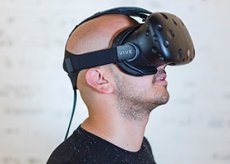Scientists have used VR to study cancer processes
Last reviewed: 16.10.2021

All iLive content is medically reviewed or fact checked to ensure as much factual accuracy as possible.
We have strict sourcing guidelines and only link to reputable media sites, academic research institutions and, whenever possible, medically peer reviewed studies. Note that the numbers in parentheses ([1], [2], etc.) are clickable links to these studies.
If you feel that any of our content is inaccurate, out-of-date, or otherwise questionable, please select it and press Ctrl + Enter.

Most of us belong to VR - virtual reality, - just like to entertainment. VR for many is associated primarily with computer games and watching movies. However, this technology is capable of becoming a powerful tool for studying cancer processes. This is what scientists from the Australian University of New South Wales recently said.
Employees of the University came up with a new technology VR, which allows to "navigate" the relief of human cells and personally observe the nucleation and death of malignant cells, including monitoring the mechanism of action of antitumor drugs.
In fact, Australian scientists were able to create a model of man in virtual reality, using modern scientific approaches, microscopic visualization and animation. Now doctors can "enter" into the human body at the level of cellular structures, only using a special headset.
However, this is not all: almost all the most important components for the procedure are available, because they are widely used in the entertainment industry. We can say that the system for studying cancer processes in some way resembles a virtual game - but very serious and purposeful.
A little earlier, scientists conducted experiments using virtual reality. However, earlier technology was used by one person for one unit of time. After a new experiment, it became possible for several specialists to penetrate the patient's tissue at once.
The next step in the research should be the delivery of chemotherapeutic drugs to the cell.
To begin with, specialists need to understand how cancer cells and the drug molecule interact. The best option is to see the whole process of interaction with your own eyes. If you monitor the movement of cells using virtual reality technology, then it becomes possible to develop cutting-edge medicines, prevent the spread of metastases, and even visually describe the subtleties of treatment directly for future patients.
A new development was demonstrated for a student audience studying at the Faculty of Pharmacy at the University of Monash. These students were studying antitumor drugs. After sessions of virtual "visiting" the body, students began to understand all the processes much better than after the usual "dry" study of the program.
"Previously, we did not have access to such virtual" excursions ". We sincerely believe that the new technology will allow scientists to recreate and trace the mechanisms of the effect of drugs at the cell level. This method is useful in almost all areas - in pharmaceutics, in practical medicine, in medical education, genetic engineering. In the end, it will be possible to adequately explain to the patient or his relatives how this or that medication will work, "explains Dr. Maria Cavallaris, opening prospects.
Scientists plan to practice diving in VR not only in clinics, but also at home, Forbes reports.

 [
[